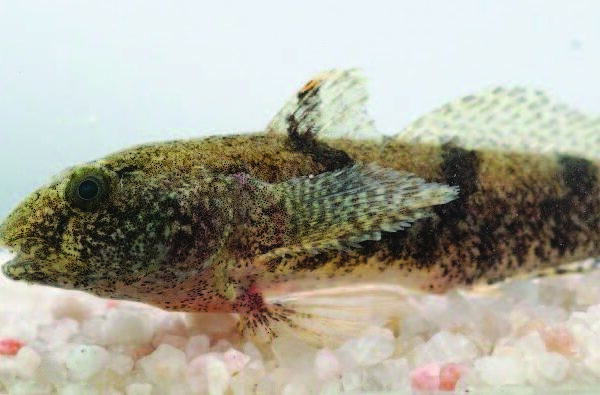Tubenose Goby

Species at a Glance
The tubenose goby (Proterorhinus semilunaris) is a small, bottom-dwelling fish that gets its name from its tubular-shaped nostrils. It feeds mainly on aquatic insects, and while its impacts are unknown, it may have negative impacts similar to that of the round goby. Although females can live for up to five years, males die immediately after spawning.
Species Description
Tubenose gobies have cylindrical bodies with small scales and a somewhat flattened underside, measuring 6-11 cm (2.4-4.3 in) in length. They have a blunt and rounded snout with a wide mouth and large lips. Tubular-shaped nostrils extend just beyond the tip of the snout. Two pelvic fins are fused into a single suction cup shaped fin and the dorsal fin is split into two distinct fins. The body is light brown with darker brown blotches that form vertical bars on the rear half of the sides. A triangular black spot is present at the base of the caudal fin, followed by two white spots.
While they may be confused with round gobies (Neogobiusmelanostomus), tubenose gobies are much smaller, have tubular shaped nostril extensions, lack a black spot on the first dorsal fin, and have eyes that do not protrude from the top of the head.
Native & Introduced Ranges
Native to the estuaries of Eurasia, including tributaries of the Black and Caspian seas, both tubenose gobies and the closely related round goby were first detected in the Lake St. Clair region around 1990, presumably released in the ballast water of ocean-going ships. While population growth of the round goby quickly escalated to the entire Great Lakes region, the tubenose goby has experienced a more limited range expansion and can be found in lakes St. Clair, Erie, and Superior.
Biology & Spread
Young tubenose gobies often resemble small bait fish and can be spread by boaters and fishermen who carry them from one body of water to another in bait buckets, bilge water, and on plant debris. Females spawn multiple times during the warmer months of the year, and males guard their nesting sites, defending the eggs and young from predators.
Habitat
Tubenose gobies prefer shallow-water habitats with abundant vegetation in slightly brackish to fresh water. They occupy a variety of waters from estuarine to slow-moving freshwater streams. Nests are created under rocks, logs, and shells.
Impacts
Threat to Biodiversity
While their impacts are not yet known, tubenose gobies may compete with and prey upon benthic species in a manner similar to the larger round goby. However, because they are small, not as aggressive, and their range expansion has been limited, the tubenose goby may not be as detrimental as the round goby.
Prevention & Control
Preventing the spread of tubenose gobies to new areas is the best way to ensure this species doesn’t cause ecological and economic damage. Anglers are often the first to discover new infestations because they are commonly caught by hook and line. Know how to identify the tubenose goby.
- Always check for and remove any plants, mud, and debris from boats, trailers, clothing, and equipment before leaving a water body.
- Since young goby can resemble baitfish, it’s important to drain water from bait buckets, bilges, and live wells before transporting to new areas.
- Clean and dry all equipment, and NEVER use round gobies as bait.
References:
Crosier, D. and Malloy, D. 2005. Round Goby. United States Federal Aquatic Nuisance Species Task Force.
Great Lakes Science Center. 2000. Fact Sheet: Round Goby: An exotic fish in the Great Lakes.
United States Fish and Wildlife Service. 2011. Round Goby Q&A.



